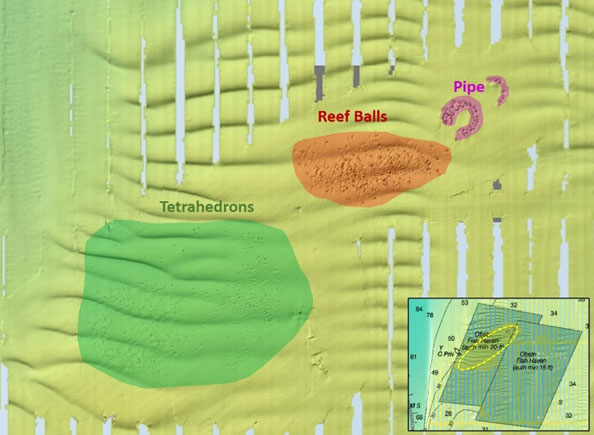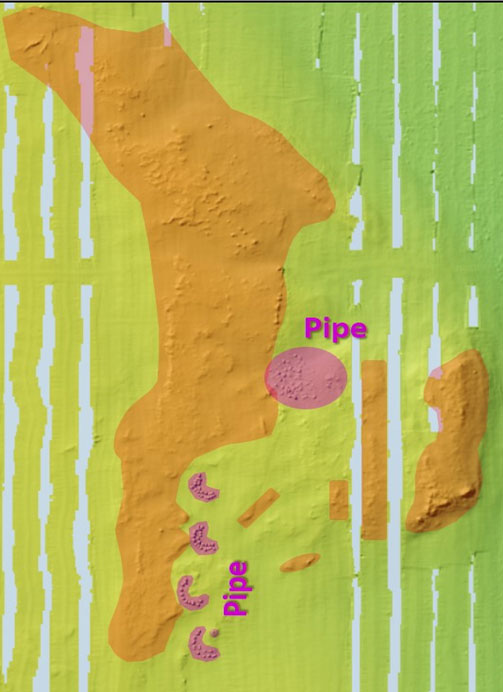Concrete pipes make an excellent reef building material, and smaller pipes can be “nested” inside larger pipes and boxes to create multiple passages through each module. This has the added benefit of increasing surface area for colonization by marine organisms. A yard full of concrete pipe, manhole seconds, and side-hole cutouts was once offered to the Maryland Artificial Reef Program by Hanson Pipe, which had previously donated pipe to the Virginia Artificial Reef Program. From a business perspective, it was less costly to donate the pipe and transportation to a waterfront location than it was to crush and recycle the defective products. So a repeat performance in the upper half of the Bay building on successful Lower Bay deployments made sense.

The reef program’s advisory committee met reef manager Tom Humbles and myself at the pipe yard. We saw about every type and size of pipe known to man. Most products were in good overall condition except for small defects, such as broken flanges or casting voids in the concrete, which made them unsuitable for commercial use. A huge pile of circular side-hole cutouts caught our attention for possible use as cultch materials for oyster restoration, fishing reefs, or both. Our feeling was unanimous – get it, transport it to permitted fish havens, and build reefs!
The Marine transportation and heavy lift equipment for placement were the tough nuts to crack. The pipe offer came after the Maryland program had transitioned from a State-funded program to a self-supporting activity in 1997. The program was hanging on by a shoestring with a very small income stream from placement inspection fees charged to donors (keeping the price of marine transportation, placement, and inspection below the cost of rubble fill disposal). Program management was mostly volunteered time. A few modest grants as well as volunteered staff time enabled the introduction of reef balls through small-scale projects with environmental and community groups. The income stream was insufficient to support a large-scale deployment.
Nevertheless, some reefs were built through providence. Sometimes, demolition projects require removal and disposal of obsolete infrastructure as part of bid submissions. This is the providential pathway for how many reefs are built – when the costs of deployment to reefs is less than the cost of rubble fill disposal or recycling. In other cases, a prospective provider is willing to support conservation and environmental improvement objectives if this can be accomplished without incurring costs in excess of other disposal options, and this is the situation we faced at the pipe yard. Tug, barge, and heavy-lift crane services were essential due to the weight, character, and configuration of the materials. Donated marine services were sought, but none were forthcoming. Our pipe dream became just that.
Since the pipe nightmare, a few concrete pipe reefs have been established in Maryland, Virginia, and the lower tidal Potomac River waters. All involved some measure of donated materials and services and volunteer support. Reefs of this type can be found in the Tangier Sound Fish Haven and also at the Potomac River Fisheries Commission Kitts Point Artificial Reef. The largest (and most recent) pipe reef among the Maryland Fish Havens was deployed in 2017 in Tangier Sound. The project was made possible by donated pipe, grant support for deployment, and volunteers. Sponsors were the Coastal Conservation Association’s (CCA) Building Conservation Trust, CCA Maryland, the Maryland Artificial Reef Initiative, Rinker Materials, and Engel Coolers. Without donated materials and deployment support, these very suitable reef building materials would have ended up in a rubble fill or crusher. Instead, they are helping restore three-dimensional reef structure and providing marine habitat and fishing opportunity.

The Northern Neck Artificial Reef is the westernmost of two fish haven trapezoids shown on nautical charts southeast of Smith Point. Why two trapezoids? There is no official explanation, or at least none that I’ve been able to ferret out. It may be related to Loran-C error during early years of the program. No matter, that’s where it is. National Oceanic and Atmospheric Administration (NOAA) side-scan sonar images are available using the agency’s Bathymetry Data Viewer. Some very interesting details are revealed. Huge sediment waves are visible across the bottom. The sediment waves are especially pronounced towards the southwest line of reefs where original deployments (concrete tetrahedrons) occurred, so much so that the majority of the designed reef units shaded in green appear largely buried. This situation is in contrast with a hard edge immediately to the north which appears to be swept clear of sediment by strong currents. Had this information and the extent of sediment movement across the site been known, perhaps a different location might have been chosen for the fish haven. Modern technology is certainly revealing things we didn’t know about our Bay! Nevertheless, two nested pipe reefs in halfmoon patterns have become a seasonal go-to hotspot for chumming stripers. How we pulled a school of stripers out from this reef under our boat is told in Bridges Under Troubled Waters.

Proceed south from Smith Point to reach the Asphalt Pile, another Virginia Marine Resources Commission (VMRC) artificial reef. It’s a long run down from Point Lookout across the mouth of the Potomac. It’s also a long road haul down to the Northern Neck for trailer boaters. However, it’s a relatively short run from the sheltered Shell Landing public launch ramp on Fleeton Creek near the mouth of the Great Wicomico River. So, if fishing reports are favorable, the haul down and maybe an overnight stay are worth considering.

This site is characterized by extensive natural hard bottom features in the surrounding area. A prominent mound with a very steep drop-off is just east of the fish haven. The VMRC reef grid shows six pipe reefs. Nested pipes were extensively deployed here. The area around the reefs appears rugged, suggesting that sediment deposition is not a problem here. The northernmost manmade structures, a large patch reef and a smaller patch reef, are within the area shaded in purple. South of these are four reefs, each configured in a half-moon-like pattern. This configuration keeps chum lines viable longer across a reef as current shifts around, although fish may orient to a specific sweet spot. Learning reef sweet spots is part of the fishing game. With all the natural and man-made structures in the area, trolling, bottom fishing, jigging, chumming, chunking, and live lining are all options.
On a positive note, the reef program limped along until it was reinvigorated through the Maryland Artificial Reef Initiative, inspired by the Wilson Bridge replacement project. Funding that enabled acquisition and placement of demolition materials was provided through a funding measure enacted by the Maryland Legislature. Bay conservationists and recreational fishermen can only hope that financial resources will be available for future material donations needing deployment support.
To learn about other reefs in the Bay, see the listings and links at Chesapeake Bay Fishing Reefs.
Author Wayne Young is a former manager of the Maryland artificial reef program for Bay waters and his book “Bridges Under Troubled Waters: Upper Chesapeake and Tidal Potomac Fishing Reefs” can be purchased at amazon.com. You can also visit his Facebook page, Chesapeake Bay Fishing Reefs.
Sign up here to get the weekly FishTalk Chesapeake Bay and Mid-Atlantic fishing reports in your email inbox, every Friday by noon.